A hat-tip must go out to the folks at Urban Indy, which, though their (our) posts may be scant, still lives on as a conversation thread. And it was through Urban Indy conversations that I learned about the article that prompted me to write here for the first time in many moons. It’s hard to imagine, but it has been five years since the Indianapolis staple Marsh Supermarkets closed its remaining locations: all 44 of them. Not a huge chain and never one of national scale, Marsh was nonetheless the most prevalent grocer in many parts of Indiana and eastern Ohio in the 1980s and 90s.
Founded by the Ermal Marsh in 1931 in Muncie, the chain grew reasonably quickly, at least by the standards of a time when most grocery stores were small-scale family operations of just a few locations. The Marsh brothers experimented with gas/convenience stores by the 1960s, opening Village Pantry (which still survives vestigially under different ownership) and acquiring competitors in central Indiana such as Mr. D’s (a competitor reduced to three locations by the early 2000s) or the entire eight-store chain of O’Malia’s Food Markets. Unbeknownst to most people (or at least to me), it was a Marsh Supermarket in eastern Ohio that, in 1974, pioneered the bar code scanner, a device ubiquitous in grocery stores across the world 50 years later. From what I can tell, Marsh was also among the first to introduce a loyalty program, Marsh Fresh IDEA, with a carrying card that tracked info and issued customized discounts, while incentivizing loyal customers to purchase other already discounted products. It used the same yellow tags we associate with supermarkets from coast to coast. At its 1990s peak, Marsh Supermarket had around 100 locations.
The company’s reputation for innovation and growth stretched it too thinly by the late 1990s, when its management of budget names like LoBill, more upscale alternatives like O’Malia’s, and an ambitious 2005 attempt to penetrate the Chicago market (the southwest suburb of Naperville) scattered its hometown-friendly image. The Naperville branch closed after less than a year. Meanwhile, Cincinnati-based megachain Kroger (the nation’s largest grocer) increased its market share in Indy, eventually overtaking Marsh. And by 2006, private equity firm Sun Capital Partners bought the chain; founding nephew Don Marsh resigned. The company persevered despite multiple shifts in management, opening its first location during Sun Capital’s ownership in 2014, in downtown Indianapolis. I featured this location in a brief article shortly after its opening. The decision raised some eyebrows: it was the first downtown grocer to open in almost 30 years (a much-smaller pre-merger O’Malia’s had effectively served the east side of downtown since 1986), and Sun Capital had scaled the company down to about 80 locations during its ownership, having just closed eight locations a few months earlier.
As nice as the widely-touted downtown Marsh looked—it had an olive bar!—the novelty could not divert enough attention away from a chain that was clearly treading water: the more far-flung locations in Indy and its suburbs still looked like the 1980s. I can remember going past one in Greenwood that only had about twelve cars parked in the middle of the day, all in the outer edges of the lot, suggesting that the location was empty except for employees. Little by little, the parent company (now based in Florida) sold off the assets, including the headquarters from Fishers. And my favorite Marsh swan-song story comes from a purchase I made from the Lockerbie Square O’Malia’s (still a Marsh brand even when the fancy new one was less than a mile away). I purchased a box of the store wholesale-brand raisin bran cereal about a year or two before they closed, and here’s what the back of the box looked like:
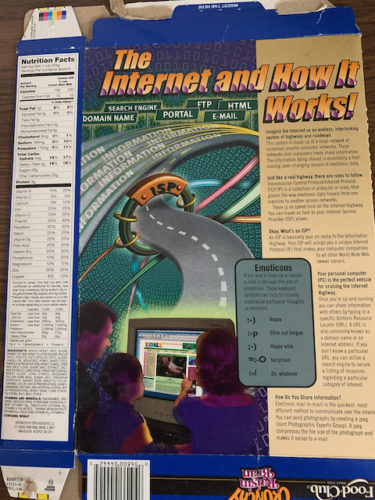
An introduction to the Internet! Neither Marsh nor the wholesale partner had changed the packaging since the early/mid 1990s.
So yeah, Marsh went belly up in 2017. Or, rather, Sun Capital liquidated it. Marsh therefore joined such other legendary Indy chains as H.H. Gregg, American Trans Air, Galyan’s Trading Company, and (for those who remember it) Burger Chef, all of which crashed and burned just as they seemed to be rising toward the big leagues. (Steak ’n Shake, will you be the next shoe to drop?) But, as the original WISH-TV article noted, interest in the remaining 44 locations wasn’t exactly surging. Kroger acquired about a dozen, but only ended up turning seven into fully-operational branches (including the shiny downtown location). A church bought one in early 2020, but nothing has happened to it (COVID certainly couldn’t have helped). A few others went to smaller chains like Needlers. At least one in Fishers got demolished. Kroger left a few shuttered, potentially in an effort to stave off competition from moving in. But at least a dozen old Marsh buildings are sitting in complete neglect, awaiting a buyer, looking like they might have been a fully functional Marsh as recently as last Tuesday. The WISH article notes that several Marsh locations were prevailing in otherwise economically underperforming parts of Indianapolis; with the chain gone and nothing to replace it, these areas are food deserts.
This action—and the observations from the recent article—prompt me to ask how Marsh could have managed to hold its own for so many decades despite operating just 100 miles away from Kroger, the nation’s grocery juggernaut (third largest retailer behind Walmart and Amazon), while Kroger operated locations in Indy for much of that time. (Marsh even opened some of its successful eastern Ohio locations in metro Cincinnati—enemy territory!) Marsh was smaller and more innovative through the 1980s, but it sank under the same leadership that pioneered its more successful strategies. I’m not here to ponder the ethical allegations that Sun Capital lodged against Don Marsh in the years after he sold them the company. Whether true or not, Sun Capital did not seem to pursue strategies that would keep its holdings profitable: many Marsh locations were too small by the standards of its emergent competitors Walmart and Meijer, let alone Kroger.
And Kroger has done exactly what it needs to do to remain a leader: reorganize its assets in response to shifting customer tastes. Take the location relatively close to where I grew up, around the far south side of Indianapolis near Greenwood. Here’s the location that I remember as a rugrat:
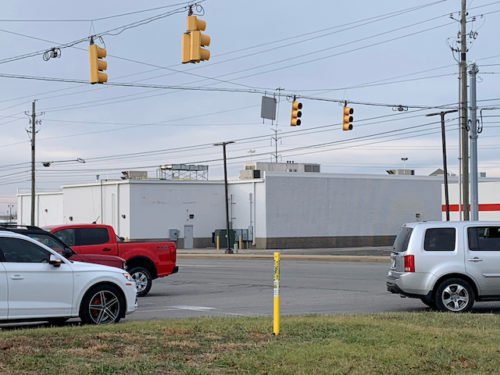
It’s a freestanding structure, and truth be told, I’m not 100% certain it didn’t involve some alteration. And here’s a view of the entrance.
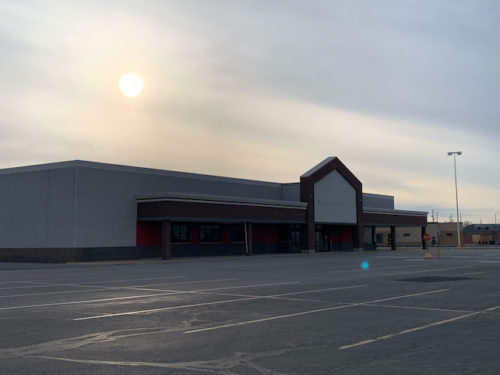
At any rate, the building is an outparcel of what was, way back in the 1980s and 90s, Target Square Mall, a mini-mall with about twelve in-line tenants, anchored by a Target, which sat directly north of the much much larger Greenwood Park Mall. (Target Square Mall is technically still functioning as Shoppes at County Line, though Target left long ago and it has no interior mall corridor.) The anchors are now Old Time Pottery and T.J. Maxx; here’s a view of the south face:
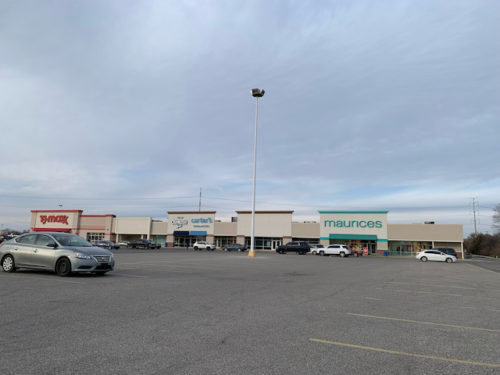
After Kroger left the area, the freestanding building eventually became an Office Max, then, after that closed, it was an Earth Fare specialty grocery in the mid 2010s; I wrote about it once. The Earth Fare chain folded completely in early 2020, though apparently it has since re-emerged and is back with about twenty locations, mostly in the southeastern US. At this point, the most likely candidate for the old Kroger is still vacant, and the site is way too small for anything other than a specialty or ethnic grocer to take it on again.
Here’s the site where Kroger relocated in (I believe) the early/mid 90s.
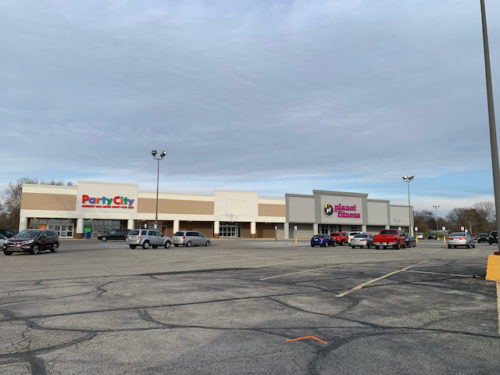
Location #2 is barely 1,000 feet north of the Location #1, in what was a newly constructed outparcel within the same Target Square Mall (later repurposed as Shoppes at County Line). It didn’t last there many years—probably less than a decade. After a vacancy, it became a kid-friendly Incredible Pizza Company for several years, then vacancy, then its split use between a Planet Fitness and Party City that we see today.
Which leads to Kroger’s Location #3:
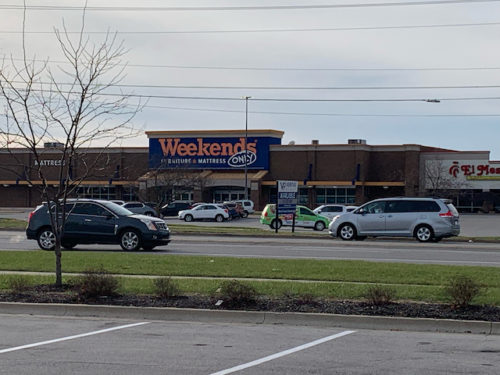
It took a slot in what had been cow pastures, at the northwest corner of County Line Road and Emerson Avenue, serving as the anchor tenant to a whole new strip mall.
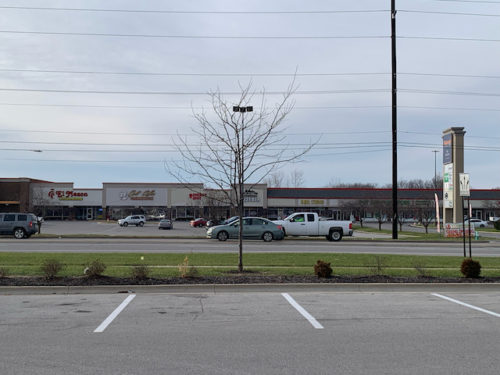
This intersection presaged an impetus for economic growth: by the mid 2000s, the state DOT approved construction of an exit ramp from Interstate 65 onto County Line Road, just a stone’s throw to the east. The opening of this exit ramp has prompted a slew of new commercial development at the County Line/Emerson intersection: a few hotels, more chain restaurants, a Walmart Supercenter, and a Costco, among other things. And, a few years ago, Kroger skipped across the road to the northeast corner of the intersection, leaving this Weekends Only in its Location #3 wake.
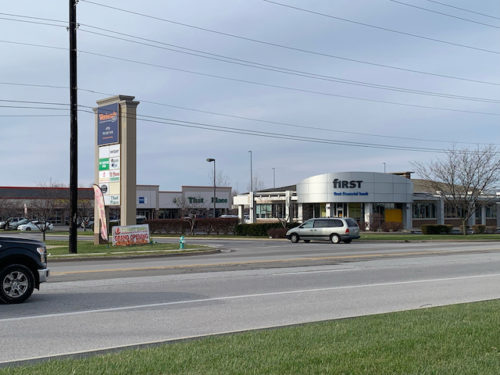
Even with an anchor tenant that is shuttered four days a week, the rest of the strip mall seems to be holding its own.
And now, here’s Kroger Location #4:
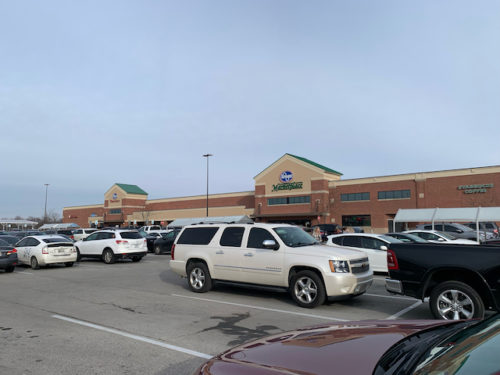
It brands itself a Kroger Marketplace, even larger, with more freshly-prepared foods, its own pharmacy, and a miniature “marketplace” with tenants accessible only from the interior:
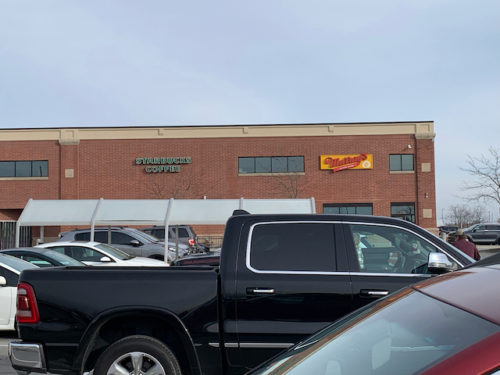
Starbucks, Murray’s Cheese, The Little Clinic, and a Great Clips. Also a drive-thru pharmacy. And (the biggest infrastructural difference from Location #3): a gas station outparcel.

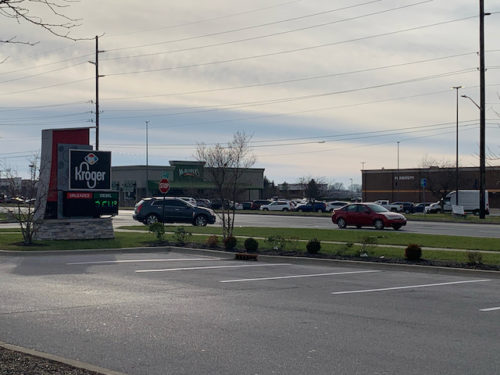

Basically, Kroger has learned that the best way to remain a cutting-edge grocer (to remain what Marsh was in the 1970s and 80s) is to sprawl like mad. No point in upgrading an aging location when there’s a greenfield nearby to build anew and saturate the new site with all the amenities that grocery shoppers are demanding in the 2020s. Keep in mind these four locations are only my memory since childhood; the company relocated its far south side Indy operations about every ten years. Here’s a map that shows the strategy, with 1-2-3-4 labeled in pink:

The region as a whole remains solidly middle class and growing at a reasonable (albeit not rapid) pace; this at least has assured that most of the vacated Kroger locations have found some tenants. But it shows a strategy that may only have worked as well because Kroger was smarter, choosier, and more strategic at picking the lily pads from which it could hop. Lacking the capital that could give it versatility, late-stage Marsh (and Sun Capital) generally lingered at aging locations and ran them to the ground. Most of them will never be a normal middle-market grocery store ever again; the fundamental architecture just doesn’t align with middle class tastes.
At least the nearest old Marsh location to these Krogers 1-4 isn’t completely shuttered. About a mile to the north of Locations 1 & 2, an old Marsh languished at Madison Avenue and Stop 11 Road, shuttering along with the rest of the company in 2017. Here it is today: a Viet Hua Supermarket. I’m happy to see that the southeast Asian community that has exploded in population in the last twenty years has found a way to put the property to good use. But, aside from a mini marketplace (featuring a bubble tea shop and sushi bar), they haven’t really upgraded the interior. It’s an old ugly Marsh, a relic from the era when the back of cereal boxes introduced us to some newfangled thing called the Internet.
Nice article!
I can’t begin to imagine what the legal implications would be, but I’d love to see an ordinance/law that, in exchange for a building permit, the owner of the building commits to tearing down an edifice that sits empty for a period of time, say two years. Return it to an undeveloped state. Would help reduce blight.
Thanks for writing! While we definitely have an oversupply of medium-sized big boxes (no doubt vacated in part because they aren’t big enough, like the Walmarts of the early 1990s), the American tendency to accumulate too much stuff has caused an explosion in self-storage facilities, and they make good sites for that. And self-storage companies often seek lower value real estate. I could see at least a handful of the mothballed Marshes getting turned to such use, if they haven’t already.
Otherwise, I’d guess most of these are staying unused because they current owner (even if that owner is the foreclosing bank) are just waiting for the next best offer, which might be tricky if its an economically stagnant blue-collar area with housing built in the 1950s. (Again pointing back to self-storage…(
One such vacant site became the first Indiana Total Wine & More liquor store, in Nora. Total took the remaining space after Aldi took a part of the old Marsh…where Whole Foods is practically next door and Kroger across 86th.
Also, around the time Kroger moved east to County Line and Emerson from 31, they also opened a store west, at Fairview and 135, to serve the growing western part of Greenwood.
Since then they opened a not-quite-super Kroger in Bargersville, about 5 miles south on 135, and took over the lease on a Marsh about halfway between the two. The Marsh remains vacant, though I have hopes that it too will become a Total Wine store. 🙂
I didn’t realize the Fairview/135 store was that “new”–not new in actuality, I know, but I figured it had been there forever. I guess we also have to keep in mind that one of the last O’Malia’s was at Meridian and County Line–not a huge competitor, but still something Kroger probably sought to pivot around as it made its interiors more upscale in the late 90s/early 2000s (about the same time Marsh stopped being a serious competitor).
I guess it’s a sign of the times that what once was a full-fledged non-specialty grocery store can now serve as the appropriate square footage for a category killer devoted entirely to booze. And associated munchies (I’ve been to a Total Wine just once). Even more telling: you may not have to wait long for another location. Not quite Bargersville, but a south side option is opening in what this article calls Old Kroger #1 (subsequently an Office Max, then an Earth Fare). https://www.ibj.com/articles/total-wine-and-more-planning-second-indianapolis-store This IBJ article is almost a year old; any evidence that this location has opened yet?
No evidence of opening. (I seldom get around to the front of the building; as you know the back faces County Line.)
However there was a dumpster visible next to the west side of the building last Sunday afternoon. So, maybe soon.
—
Re Kroger and O’Malias. As you probably noticed last time you were in town, the old O’Malia store is now an Ace Hardware. IIRC it opened in the early 80s, followed by Kroger. (Friends bought their first house nearby and the O’Malia store was a big draw.)
Aaaand…Total Wine indeed opened in the former Kroger/Earth Fare in late summer of 2022.
Thanks for your thoroughness, Chris. Good to know that site didn’t end up staying vacant all that long.
28wps7
ytby7s
2624wy
fsgln4
qrpfyx
q5qje5
2l892h